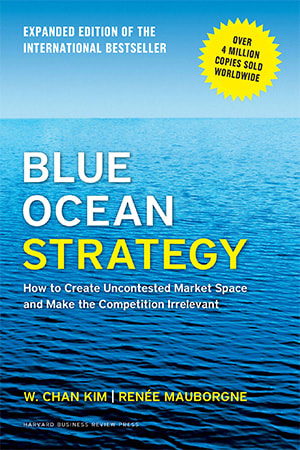 One of my favourite business books of all time is “Blue Ocean Strategy” by Chan Kim and Renée Mauborgne. It was first published in 2005 and has since been published in forty-three languages with over four and a half million copies sold. The basic premise is that most businesses compete in a “Red Ocean”, symbolized by the blood spilled from the fierce, undifferentiated competition in industries with low margins and stagnant or declining demand. The book, and an assortment of online courses and tools that have since been developed by the authors, help business owners and management teams move their business towards a “Blue Ocean”, where they simultaneously lower costs and grow in uncontested market space by creating new demand. Think about how crazy it would have sounded years ago to have a watch that measures your heartbeat or a phone that takes pictures. The shift to a Blue Ocean market requires that business owners think outside the box and is by no means easy to implement. The first step is to initiate a change in mindset and to explore the possibilities. Most businesses have invested heavily in their current market space, by investing in real assets such as equipment, facilities, etc. as well as soft assets such as the workforce, customer relationships, training, IP, marketing, etc. It can be incredibly difficult to pivot a business from the Red Ocean into a new market unless everyone buys in. For relatively successful, established, larger organizations, the organizational mindset change needed can be monumental with embedded agendas, politics, systems, etc. In these cases, it is likely best to implement a Blue Ocean strategy in a specific business unit or product line where the chances of buy-in and success are higher. Theoretically, smaller, more nimble, entrepreneurial-led businesses in the lower-middle market are much more adept at implementing a Blue Ocean strategy. Traditional strategies focus on differentiating yourself by focusing on your core strengths with specific customer segments within your existing market, by either lowering costs or adding unique value. Blue Ocean strategies entail utilizing your core strengths to open up brand new markets by creating new demand. It typically requires the use of the right side of your brain. However, for those of you like me that seem to be deficient in the creativity department, the Blue Ocean book along with the tools it outlines, help you and your team find those viable opportunities to pursue that can begin to move your business, business unit, product line, or product into a new uncontested market space. Once the creative juices are flowing and the mindset has changed, the next step is to pick the best opportunity and begin to formulate the strategy and its implementation roadmap. The book walks the reader through ways to break through traditional competitive market boundaries and reconstruct them to unlock value with current “non-customers”. It also addresses the multitude of traps and obstacles that you are likely to encounter along the way. The critics say that for many businesses moving to a Blue Ocean is nearly impossible. In the end, the book helps owners think about ways to innovate and refocus their efforts on where to invest their time, energy, and resources by moving away from the highly contested Red Ocean and leveraging their core strengths and capabilities. In my humble opinion, most people will garner some ideas that they can use, regardless of what business they are in.
0 Comments
Leave a Reply. |
AuthorWrite something about yourself. No need to be fancy, just an overview. Archives
June 2025
Categories |
